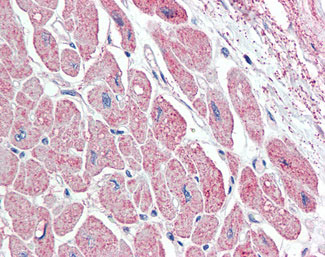NPPA / ANP Antibody (C-Terminus)
Goat Polyclonal Antibody
- SPECIFICATION
- CITATIONS
- PROTOCOLS
- BACKGROUND

Application
| WB, IHC-P, E |
|---|---|
| Primary Accession | P01160 |
| Reactivity | Human, Mouse, Rat, Rabbit, Hamster, Monkey, Sheep, Horse, Bovine, Dog |
| Host | Goat |
| Clonality | Polyclonal |
| Calculated MW | 17kDa |
| Dilution | ELISA (1:32000), IHC-P (5 µg/ml), WB (0.01-0.03 µg/ml) |
| Gene ID | 4878 |
|---|---|
| Other Names | Natriuretic peptides A, CDD-ANF, Cardiodilatin, CDD, Cardiodilatin-related peptide, CDP, Prepronatriodilatin, Atrial natriuretic factor, ANF, Atrial natriuretic peptide, ANP, NPPA, ANP, PND |
| Target/Specificity | Human NPPA. The immunizing peptide represents aa137-150 of the precursor NPPA. |
| Reconstitution & Storage | Store at -20°C. Minimize freezing and thawing. |
| Precautions | NPPA / ANP Antibody (C-Terminus) is for research use only and not for use in diagnostic or therapeutic procedures. |
| Name | NPPA |
|---|---|
| Synonyms | ANP, PND |
| Function | [Atrial natriuretic peptide]: Hormone that plays a key role in mediating cardio-renal homeostasis, and is involved in vascular remodeling and regulating energy metabolism (PubMed:8653797, PubMed:7595132, PubMed:2825692, PubMed:7720651, PubMed:8087923, PubMed:2532366, PubMed:22307324, PubMed:18835931, PubMed:21672517, PubMed:15741263, PubMed:16875975). Acts by specifically binding and stimulating NPR1 to produce cGMP, which in turn activates effector proteins, such as PRKG1, that drive various biological responses (PubMed:25401746, PubMed:9893117, PubMed:1672777, PubMed:1660465, PubMed:2162527, PubMed:2825692, PubMed:7720651, PubMed:22307324, PubMed:8384600, PubMed:21098034). Regulates vasodilation, natriuresis, diuresis and aldosterone synthesis and is therefore essential for regulating blood pressure, controlling the extracellular fluid volume and maintaining the fluid-electrolyte balance (PubMed:8653797, PubMed:7595132, PubMed:2825692, PubMed:7720651, PubMed:2532366, PubMed:8087923). Also involved in inhibiting cardiac remodeling and cardiac hypertrophy by inducing cardiomyocyte apoptosis and attenuating the growth of cardiomyocytes and fibroblasts (PubMed:16875975). Plays a role in female pregnancy by promoting trophoblast invasion and spiral artery remodeling in uterus, and thus prevents pregnancy-induced hypertension (By similarity). In adipose tissue, acts in various cGMP- and PKG-dependent pathways to regulate lipid metabolism and energy homeostasis (PubMed:22307324, PubMed:18835931, PubMed:21672517, PubMed:15741263). This includes up-regulating lipid metabolism and mitochondrial oxygen utilization by activating the AMP-activated protein kinase (AMPK), and increasing energy expenditure by acting via MAPK11 to promote the UCP1-dependent thermogenesis of brown adipose tissue (PubMed:22307324, PubMed:18835931, PubMed:21672517, PubMed:15741263). Binds the clearance receptor NPR3 which removes the hormone from circulation (PubMed:1672777). |
| Cellular Location | [Long-acting natriuretic peptide]: Secreted. Note=Detected in blood. [Kaliuretic peptide]: Secreted. Note=Detected in blood [Atrial natriuretic peptide]: Secreted. Perikaryon. Cell projection. Note=Detected in blood (PubMed:8351194, PubMed:8779891, PubMed:7955907, PubMed:8653797, PubMed:15741263, PubMed:18835931, PubMed:2532366, PubMed:7984506). Detected in urine in one study (PubMed:8351194). However, in another study, was not detected in urine (PubMed:7984506). Detected in cytoplasmic bodies and neuronal processes of pyramidal neurons (layers II-VI) (PubMed:30534047) Increased secretion in response to the vasopressin AVP (By similarity) Likely to be secreted in response to an increase in atrial pressure or atrial stretch (PubMed:2532366). In kidney cells, secretion increases in response to activated guanylyl cyclases and increased intracellular cAMP levels (PubMed:9893117). Plasma levels increase 15 minutes after a high-salt meal, and decrease back to normal plasma levels 1 hr later (PubMed:8779891). {ECO:0000250|UniProtKB:P01161, ECO:0000269|PubMed:15741263, ECO:0000269|PubMed:18835931, ECO:0000269|PubMed:2532366, ECO:0000269|PubMed:30534047, ECO:0000269|PubMed:7955907, ECO:0000269|PubMed:7984506, ECO:0000269|PubMed:8351194, ECO:0000269|PubMed:8653797, ECO:0000269|PubMed:8779891, ECO:0000269|PubMed:9893117} |
| Tissue Location | [Urodilatin]: Detected in the kidney distal tubular cells (at protein level) (PubMed:9794555, PubMed:8384600). Present in urine (at protein level) (PubMed:2972874, PubMed:9794555, PubMed:8351194, PubMed:8779891). |

Thousands of laboratories across the world have published research that depended on the performance of antibodies from Abcepta to advance their research. Check out links to articles that cite our products in major peer-reviewed journals, organized by research category.
info@abcepta.com, and receive a free "I Love Antibodies" mug.
Provided below are standard protocols that you may find useful for product applications.
Background
Hormone playing a key role in cardiovascular homeostasis through regulation of natriuresis, diuresis, and vasodilation. Also plays a role in female pregnancy by promoting trophoblast invasion and spiral artery remodeling in uterus. Specifically binds and stimulates the cGMP production of the NPR1 receptor. Binds the clearance receptor NPR3.
References
Oikawa S.,et al.Nature 309:724-726(1984).
Nakayama K.,et al.Nature 310:699-701(1984).
Nemer M.,et al.Nature 312:654-656(1984).
Greenberg B.D.,et al.Nature 312:656-658(1984).
Seidman C.E.,et al.Science 226:1206-1209(1984).
If you have used an Abcepta product and would like to share how it has performed, please click on the "Submit Review" button and provide the requested information. Our staff will examine and post your review and contact you if needed.
If you have any additional inquiries please email technical services at tech@abcepta.com.













 Foundational characteristics of cancer include proliferation, angiogenesis, migration, evasion of apoptosis, and cellular immortality. Find key markers for these cellular processes and antibodies to detect them.
Foundational characteristics of cancer include proliferation, angiogenesis, migration, evasion of apoptosis, and cellular immortality. Find key markers for these cellular processes and antibodies to detect them. The SUMOplot™ Analysis Program predicts and scores sumoylation sites in your protein. SUMOylation is a post-translational modification involved in various cellular processes, such as nuclear-cytosolic transport, transcriptional regulation, apoptosis, protein stability, response to stress, and progression through the cell cycle.
The SUMOplot™ Analysis Program predicts and scores sumoylation sites in your protein. SUMOylation is a post-translational modification involved in various cellular processes, such as nuclear-cytosolic transport, transcriptional regulation, apoptosis, protein stability, response to stress, and progression through the cell cycle. The Autophagy Receptor Motif Plotter predicts and scores autophagy receptor binding sites in your protein. Identifying proteins connected to this pathway is critical to understanding the role of autophagy in physiological as well as pathological processes such as development, differentiation, neurodegenerative diseases, stress, infection, and cancer.
The Autophagy Receptor Motif Plotter predicts and scores autophagy receptor binding sites in your protein. Identifying proteins connected to this pathway is critical to understanding the role of autophagy in physiological as well as pathological processes such as development, differentiation, neurodegenerative diseases, stress, infection, and cancer.



